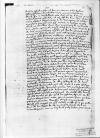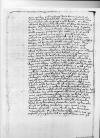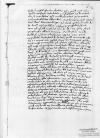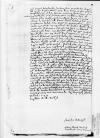Quae hic a ⌊Constellato⌋ acta sint, et ex litteris, quas cubicularius attulit, et ex scheda ⌊reverendissimi domini⌋, quam nunc affert ⌊Mauricius⌋, Reverendissima Dominatio cognoscet. Eadem repetere necesse non est. Litterae in ⌊urbem⌋ missae sunt ac servitori ⌊reverendissimi domini⌋, ⌊Conopnicki⌋, inscriptae, cui etiam exempla missa sunt, quae cum ⌊nepote⌋ R(everendissimae) D(ominationis) Vestrae ms. a(!)
⌈aeae ms. a(!)
⌉ communicare iussus est. De domino ⌊Ioanne⌋ mihi numquam fuit dubium, quin ⌊Alexandri⌋ partibus faveret, sed honorari medicum oportet propter necessitatem. Litteras ⌊nepotis⌋ Reverendissimae Dominationis Vestrae legi. Metuo, ne regiae tardius perferantur, in ipsas enim vacationes incident. Sed menses aliquot peregrinando consumpsimus neque certi hominis potestas dabatur, qui eas in ⌊urbem⌋ perferret. Spero equidem terrorem iniectum iri iis, qui regiae detrahunt dignitati. De ⌊Locka⌋ invitus audio, quod non est in officio, ne nos quidem scimus hic, quid agat, quid cogitet, aut ubi locorum sit. Ipsius res agitur, ipse viderit.
Cum ⌊vicino⌋ esse in gratia Reverendissimam Dominationem Vestram gaudeo. ⌊Constellatus⌋ quo loco sit apud eum futurus, nescio, quandoquidem duos parietes de eadem fidelia dealbare vix poterit. Intelligit, credo, quid velim Reverendissima Dominatio Vestra. ⌊Reverendissimus dominus⌋ vehementer est animo erga eum exacerbato; omnia se facturum dixit, ut ne claves ⌊civitatis⌋ ei credantur. De pace cum ⌊Danis⌋ spes quidem est non exigua, sed confecta iam esse non videtur, sicut ex particula litterarum domini ⌊Mischkowski⌋ Reverendissima Dominatio Vestra cognoscet. De terribili casu illo secus se rem written over s⌈smm written over s⌉ habere narrat ⌊Volski⌋. Deiectos quidem tempestate quosdam equites, sed nihil inde detrimenti accepisse, praeterquam quod unus equus crus fregit. De clade illa verum est, sed verum et hoc, quod prophetico spiritu Reverendissima Dominatio Vestra praedixit. Iam enim ignominiam hanc quodam glorioso facinore marchio Guasti compensavit. Quod quo magis ita esse credat, mitto quae ex aula serenissimi domini ⌊Romanorum regis⌋ de ea re scripta sunt. Sed et ⌊Lucenburgum⌋ iam in ⌊caesaris⌋ potestatem pervenit.  FG, Chart. A 381, f. 24v Spero equidem, quod respiciet Deus ⌊divos fratres⌋ et eorum consilia fortunabit. Quorum ⌊alterius⌋ ⌊filia⌋ uno omnium ore in gratia esse dicitur. Nondum advenit ⌊desideratus⌋, sed octavo ab hinc die venturus dicitur. Quid futurum sit, videbimus, neque latebit Reverendissimam Dominationem Vestram.
FG, Chart. A 381, f. 24v Spero equidem, quod respiciet Deus ⌊divos fratres⌋ et eorum consilia fortunabit. Quorum ⌊alterius⌋ ⌊filia⌋ uno omnium ore in gratia esse dicitur. Nondum advenit ⌊desideratus⌋, sed octavo ab hinc die venturus dicitur. Quid futurum sit, videbimus, neque latebit Reverendissimam Dominationem Vestram.
Neque Nicolai Glogau, neque Iacobi Stolle nomine quicquam hic actum est. Si quid egerint, dabitur a me opera, quoad eius fieri poterit, ne proficiant aliquid. Sed celare non possum Reverendissimam Dominationem Vestram, quod a ⌊fratribus Polplinensibus⌋ dicitur ab hoc Iacobo Stolle ius esse omne dominum Grabau consecutum. Cuius causam, quod mihi tantopere commendat Reverendissima Dominatio Vestra, cupio certe illius iustitiam adiutam. Sed sententiae per iudices latae, qualis executio fieri debeat, equidem non video. Scit Reverendissima Dominatio Vestra iudicium non esse nisi rei certae. Multo magis sententia certum aliquid in se habeat oportet. In hac vero sententia, quam ego legi, nam aliam nullam vidi, nihil aliud scriptum reperit, nisi ut restituant ⌊fratres⌋, si quod plus acceperunt. De aestimatione bonorum verbum nullum. Contra quam dixissent fortasse ⌊fratres⌋ aliquid aut appellasent. Nam ab hac quidem sententia, ita, ut scripta est, nihil erat, quod appellarent, cum se gravatos non sentirent. Post factam bonorum aestimationem adhuc non reperio, quod ventum sit ad iudicem, quod pars citata quodque ei contradicendi potestas facta fuerit. Quae nihil aliud petit supplex, quam ut audiatur. Hoc certe negari illi non potest, prius enim executionem fieri, quam auditae sint partes, quam aequum sit, nescio.
Vellem itaque significari per Vestram Reverendissimam Dominationem, num sit sententia lata de aestimatione facienda, num aestimatio fuerit in iudicio producta, num contra eam dictum aliquid, num finale postea decretum intercesserit. Quod si intercessit, salva res est Achatii, si praesertim ab eo appellatum non est.  FG, Chart. A 381, f. 25r Sed si nihil horum factum est, quid erit iuri ipsius Achatii detractum, si fratres audientur, ne se inauditos esse condemnatos querantur. Lamentabiliter admodum imploraverunt opem reverendissimi domini Marienburgi, qui erat acturus cum Reverendissima Dominatione Vestra, nisi publica negotia prohibuissent. Non est, quod metuat Vestra Reverendissima Dominatio, ne qua fiat propinquo illius iniura. Audiatur modo abbas, iustitia cuiusquam ea re non erit impedita.
FG, Chart. A 381, f. 25r Sed si nihil horum factum est, quid erit iuri ipsius Achatii detractum, si fratres audientur, ne se inauditos esse condemnatos querantur. Lamentabiliter admodum imploraverunt opem reverendissimi domini Marienburgi, qui erat acturus cum Reverendissima Dominatione Vestra, nisi publica negotia prohibuissent. Non est, quod metuat Vestra Reverendissima Dominatio, ne qua fiat propinquo illius iniura. Audiatur modo abbas, iustitia cuiusquam ea re non erit impedita.
Recte facit Reverendissima Dominatio Vestra, quod commento illi de 50 aureis non credit, nam ne teruncius quidem unus mihi promissus est. Fateor equidem obtrusos esse mihi nequicquam recusanti duos aureos non alia de causa, quam ut aditum pararem ad reverendissimum dominum. Sed certe si 1000 darentur, tanti mihi non essent, ut iniustam causam adiutam vellem. Credat mihi Reverendissima Dominatio Vestra, usu venisse nonnumquam, ut et promissis magnis onerarer et prae manu darentur non contemnenda. Sed me tamen adduci nequaquam potuisse, ut contra fidem meam facerem, quae solidior est et firmior, Deo gratiam suam suppeditante, quam ut vel ⌊Croesi⌋ opes eam possint expugnare. Melius est enim nomen bonum quam divitiae multae.
Habebit Reverendissima Dominatio Vestra mandatum his adiunctum, per quod sententia conservatur in suo robore, ita tamen, quod suis exceptionibus utendi potestas ⌊abbati⌋ permittitur. Quod ⌊Glasaw⌋ attinet, obtinuit is insolita forma litteras moratorias, quo tempore ego fui ⌊Cracoviae⌋. Miserat ad me ⌊Constellatus⌋, ut ad me adeundi potestatem sibi facerem. Ego me potius ad illum venturum dixi ac praeverti eum, existimabam enim seriis de rebus mecum acturum. Ille mihi litterarum exemplum protulit written over ...⌈... illegible⌈...... illegible⌉tulittulit written over ...⌉ gravi cum querimonia, quod eiusmodi ex cancellaria prodiissent, rem vehementer exaggerando ac Lutheranismo etiam ipso  FG, Chart. A 381, f. 25v magis detestando. Habere se in mandatis dixit, ut coram ⌊regia maiestate⌋, quae dari litteras hoc genus prohibuisset, sed se tamen minime facturum, si melior hidden by binding⌈[elior]elior hidden by binding⌉ ratio on the margin⌈ratioratio on the margin⌉ inventa sit, qua succurratur creditoribus, et litterae istae infirmentur. Qua de re scriptas etiam a senatu ad ⌊reverendissimum dominum⌋ litteras ut eas perferrem, dedit. Cum legerem exemplum, sum certe miratus ac excusavi, ut potui, ⌊reverendissimum dominum⌋. Ceterum litteras a senatu ut ipse redderet, satius esse dixi. Contendit ille, ut ego potius. Quod feci ac ex ⌊reverendissimo domino⌋ cognovi, quod ea forma litteras invitus dederit contendente ⌊hera⌋ et ⌊primate⌋, se vero frustra renitente. Quare iussit, quod ei significarem, ut coram ⌊regia maiestate⌋ quereretur. Quod ita significando hidden by binding⌈[do]do hidden by binding⌉ eum ad me pro responso mitteret. Quomodo ille postea rem egerit, nescio. Hoc tantum scio, quod hidden by binding⌈[d]d hidden by binding⌉ misit ⌊hera⌋, ut loco quinquennii biennium scriberetur, ut adiungeretur, quod creditoribus satisdare teneretur, se expleto biennio soluturum hidden by binding⌈[rum]rum hidden by binding⌉ et executio facta ne impedietur. Quae ita scripta hidden by binding⌈[a]a hidden by binding⌉ sunt cumque vellet ⌊ipsa⌋ litteras ⌊Gedanum⌋ mittere, sui id officii esse dixit ⌊reverendissimus dominus⌋, seque missurum. Litteras tamen, quibus prorogatio data est ⌊Gedanensibus⌋ annuum suum ⌊regiae maiestati⌋ solvendi hidden by binding⌈[ndi]ndi hidden by binding⌉ ad natalem Christi proximum, ei ut mitteret, dedit.
FG, Chart. A 381, f. 25v magis detestando. Habere se in mandatis dixit, ut coram ⌊regia maiestate⌋, quae dari litteras hoc genus prohibuisset, sed se tamen minime facturum, si melior hidden by binding⌈[elior]elior hidden by binding⌉ ratio on the margin⌈ratioratio on the margin⌉ inventa sit, qua succurratur creditoribus, et litterae istae infirmentur. Qua de re scriptas etiam a senatu ad ⌊reverendissimum dominum⌋ litteras ut eas perferrem, dedit. Cum legerem exemplum, sum certe miratus ac excusavi, ut potui, ⌊reverendissimum dominum⌋. Ceterum litteras a senatu ut ipse redderet, satius esse dixi. Contendit ille, ut ego potius. Quod feci ac ex ⌊reverendissimo domino⌋ cognovi, quod ea forma litteras invitus dederit contendente ⌊hera⌋ et ⌊primate⌋, se vero frustra renitente. Quare iussit, quod ei significarem, ut coram ⌊regia maiestate⌋ quereretur. Quod ita significando hidden by binding⌈[do]do hidden by binding⌉ eum ad me pro responso mitteret. Quomodo ille postea rem egerit, nescio. Hoc tantum scio, quod hidden by binding⌈[d]d hidden by binding⌉ misit ⌊hera⌋, ut loco quinquennii biennium scriberetur, ut adiungeretur, quod creditoribus satisdare teneretur, se expleto biennio soluturum hidden by binding⌈[rum]rum hidden by binding⌉ et executio facta ne impedietur. Quae ita scripta hidden by binding⌈[a]a hidden by binding⌉ sunt cumque vellet ⌊ipsa⌋ litteras ⌊Gedanum⌋ mittere, sui id officii esse dixit ⌊reverendissimus dominus⌋, seque missurum. Litteras tamen, quibus prorogatio data est ⌊Gedanensibus⌋ annuum suum ⌊regiae maiestati⌋ solvendi hidden by binding⌈[ndi]ndi hidden by binding⌉ ad natalem Christi proximum, ei ut mitteret, dedit.
Haec ego pluribus scripsi, ut quomodo res acta sit Reverendissima Dominatio Vestra cognosceret. Videtur itaque iam non esse necessarium, ut quo volebat exemplo ad ⌊Glasaw⌋ litterae scribantur, cum datus ei salvus conductus sit iam valde lacer. Si tamen opus esse iudicaverit, mittentur.
Deum precor, ut Reverendissimam Dominationem Vestram quam diutissime servet incolumem et felicem. Cuius me gratiae commendo.
 FG, Chart. A 381, f. 24v Spero equidem, quod respiciet Deus
FG, Chart. A 381, f. 24v Spero equidem, quod respiciet Deus  FG, Chart. A 381, f. 25r Sed si nihil horum factum est, quid erit iuri ipsius Achatii detractum, si fratres audientur, ne se inauditos esse condemnatos querantur. Lamentabiliter admodum imploraverunt opem reverendissimi domini Marienburgi, qui erat acturus cum Reverendissima Dominatione Vestra, nisi publica negotia prohibuissent. Non est, quod metuat Vestra Reverendissima Dominatio, ne qua fiat propinquo illius iniura. Audiatur modo abbas, iustitia cuiusquam ea re non erit impedita.
FG, Chart. A 381, f. 25r Sed si nihil horum factum est, quid erit iuri ipsius Achatii detractum, si fratres audientur, ne se inauditos esse condemnatos querantur. Lamentabiliter admodum imploraverunt opem reverendissimi domini Marienburgi, qui erat acturus cum Reverendissima Dominatione Vestra, nisi publica negotia prohibuissent. Non est, quod metuat Vestra Reverendissima Dominatio, ne qua fiat propinquo illius iniura. Audiatur modo abbas, iustitia cuiusquam ea re non erit impedita.
 FG, Chart. A 381, f. 25v magis detestando. Habere se in mandatis dixit, ut coram
FG, Chart. A 381, f. 25v magis detestando. Habere se in mandatis dixit, ut coram 


